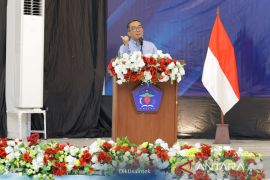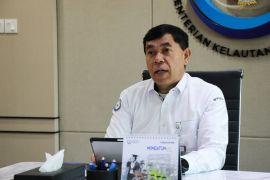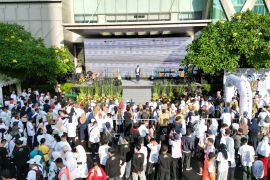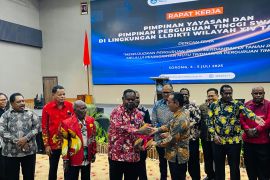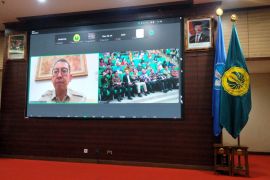HONG KONG, June 17, 2016 - (Antara) - The Hong Kong Trade Development Council (HKTDC) has announced its HKTDC Export Index for the second quarter of 2016 (2Q16), which, at 37.2, was little changed from the previous quarter. Despite early signs of stabilisation in the global economy, and in view of lacklustre export figures in the first half of this year, HKTDC Research projects that Hong Kong exports in 2016 will shrink by four per cent compared to last year, down from its previous forecast of zero growth at the end of 2015.
Mixed Signals: Exports projected to decline but bright spots identified
HKTDC Director of Research Nicholas Kwan said, "Against the backdrop of a choppy trade environment and sluggish global demand in 2016, Hong Kong's export performance has so far been below expectations and total exports in the first four months fell 5.6 per cent year-on-year. At the beginning of this year, triggered by fears over a disruptive slowdown of the Chinese economy, aggravated by waning growth in the United States and sustained deflationary pressures in the European Union and Japan, both business and consumer confidence fell in most parts of the world alongside plunging crude prices.
"Yet, it is expected that the global trade environment may stabilise in the medium term. There are signs that the US economy is regaining momentum, the Chinese economy has found a firmer footing, while firmer oil prices are also giving some breathing space for commodity exporting countries. It can therefore be inferred that overall external demand is going to revive gradually and, in the medium term, the global trade environment should improve."
The HKTDC Export Index, which measures the sentiment of local exporters, was 37.2 in 2Q16, slightly lower than the previous quarter's recording of 37.3. A reading below 50 indicates sluggish export performance over the short-term. However, the prospects for various industries are mixed, according to Mr Kwan. "The signs of stabilisation in the Export Index reflect that Hong Kong exporters' confidence is stabilising. Still, a pessimistic sentiment on market prospects prevails as far as short-term export performance is concerned," he said.
Although the Export Index for 2Q16 was virtually unchanged from 1Q16, the performance of some industries is seen as more encouraging. For the machinery and toys industries, the indices rebounded to above 40 for the first time this year. However, jewellery exporters see strong headwinds with the jewellery index falling to 21.6, its lowest level since the second quarter of 2009. "From a macro perspective, there is a good chance that the external environment as a whole would stabilise gradually and become more conducive to Hong Kong's exports," said Mr Kwan. "The sales outlook should thus improve somewhat over the medium term, although different industries will still have their share of difficulties and challenges."
Exporters' confidence in the performance of major markets remained cautious. Among Hong Kong's four major markets, the export index for Japan stood at 47.4, unchanged from 1Q16 and the highest reading among major markets, followed by the US (45.8) and the Chinese mainland (45.8). The index for the EU was 44.3.
Gradual recovery seen for major markets while emerging markets continue to show potential
After a shaky start to 2016, the global economy has recently seen early signs of stabilisation. In the developed world, the US will continue to lead the pack as the slowdown in recent months appears to be temporary. Consumer spending will remain a key driver, aided by low unemployment, steady payroll gains, an improving housing market, better household balance sheets and stronger consumer confidence.
In the EU, economic recovery, while slower than that of the US, will be led by domestic demand on the back of low crude prices, bold quantitative easing measures and a rebound in investment. Nevertheless, HKTDC Principal Economist (Global Research) Daniel Poon cautioned that the EU economy is still facing substantial downside risks. The United Kingdom's referendum on EU membership on 23 June is a cause for concern, as an exit vote will likely hurt the wider EU by disrupting well-established economic and trade relations between the EU and the UK.
In Japan, economic growth will remain subdued, with the impact of Abenomics and quantitative easing measures apparently waning. A stronger yen should weigh on Japanese exports, and the gloomy sales outlook is expected to drag on business investment. On a more positive note, consumer sentiment may get a temporary lift by the postponement until October 2019 of the second round of consumption tax increases.
Mr Poon also pointed out that developing Asia will remain the world's most dynamic region. "The Chinese mainland is pursuing a more sustainable and steadier growth based on consumption while striving to achieve a moderately prosperous society by 2020 under the 13th Five-Year Plan," he said. "It is expected that supply-side reforms would free up market vitality gradually." He asserted that the mainland's various strategies, particularly the Belt and Road Initiative, should facilitate economic upgrading and increased integration in the world economy.
Regarding other emerging markets, India is a bright spot not to be overlooked, with rising domestic demand expected to boost economic momentum while its huge population provides an ample supply of labour. Meanwhile, the economic growth of ASEAN is expected to continue, underpinned by greater regional integration, growing inward foreign direct investment and robust domestic demand. Mr Poon suggested that ASEAN countries, particularly Vietnam due to its inclusion in the Trans-Pacific Partnership (TPP), as well as Indonesia and Myanmar are attractive manufacturing locations for Hong Kong and foreign companies, as the production environment on the mainland becomes increasingly challenging.
Myanmar: Smooth political transition underscores enormous manufacturing potential
As production costs on the mainland continue to rise, more manufacturers from the Pearl River Delta region and Hong Kong are relocating their production lines to Southeast Asia. The smooth transition to a new government in Myanmar in April should usher in national policy reforms and lay the groundwork for the development of the country's manufacturing sector. HKTDC Research recently embarked on a field trip to Myanmar to study the production environment and market conditions of the country and to assess its potential as an emerging production base.
Subsequent to the lifting of sanctions against Myanmar by the West, the National League for Democracy Party won a landslide victory in the national parliamentary elections in November 2015, thus injecting new momentum into the country's economic and political reforms. The new democratically elected government has promised to further liberalise the market to attract international businesses. Dickson Ho, HKTDC Principal Economist (Asian and Emerging Markets), said, "The market expects that the receding of political risks and the smooth transition of government will attract a new wave of investment from overseas. During our fact-finding trip, both government departments and private companies that we met were invariably quite optimistic about the economic prospects of the country."
In actively carrying out economic reforms, the Myanmar government is strategically shifting the country's development focus from agriculture to industry. The country's sizeable population of over 54 million people offers a ready pool of young workers for manufacturing industries including garment, footwear, timepieces and food processing. Furthermore, with the aim of creating a positive business environment for investors, the Myanmar government has adopted export- and FDI-led development strategies and is introducing special economic zones and more industrial areas.
Myanmar also enjoys a geographical advantage due to its location between China and India, two of the world's biggest emerging markets, while bordering three other Asian countries, namely Bangladesh, Thailand and Laos. China's Belt and Road Initiative is also expected to fast-track infrastructure development such as transport, energy and telecom networks along various trade routes. Therefore, Myanmar could serve as an important logistics hub for regional trade and investment.
Mr Ho added that, despite Myanmar's low labour costs, there is much room for improvement in training management and technical personnel. Also, Hong Kong companies should note that Myanmar's water supply and sewage systems, as well as its power supply are still in an early stage of development. In terms of infrastructure, the country is still at a starting point compared with more advanced ASEAN countries. Nevertheless, with the government's commitment to reform and economic development, Myanmar is expected to become ASEAN's next low-cost manufacturing powerhouse, a hotspot increasingly drawing the attention of international sourcing companies.
Conversations with the economists:
Podcast: Export Performance http://bit.ly/1UyTwkE
Podcast: Market Outlook http://bit.ly/1XWAonV
Photo Captions: http://bit.ly/1UufYQ2
Media Registration: Media representatives wishing to cover the event may register on-site with their business cards and/or media identification.
To view press releases in Chinese, please visit http://mediaroom.hktdc.com/tc
Reporter: PR Wire
Editor: PR Wire
Copyright © ANTARA 2016

